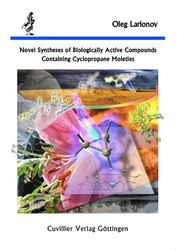| Areas | |
|---|---|
| Serie de libros (96) |
1378
|
| Nachhaltigkeit |
3
|
| Gesundheitswesen |
1
|
| Letra |
2362
|
| Ciencias Naturales |
5406
|
| Matemática | 229 |
| Informática | 319 |
| Física | 980 |
| Química | 1363 |
| Geociencias | 131 |
| Medicina humana | 243 |
| Estomatología | 10 |
| Veterinaria | 108 |
| Farmacia | 147 |
| Biología | 835 |
| Bioquímica, biología molecular, tecnología genética | 121 |
| Biofísica | 25 |
| Nutrición | 45 |
| Agricultura | 1004 |
| Silvicultura | 201 |
| Horticultura | 20 |
| Ecología y conservación de la tierra | 148 |
| Ciencias Ingeniería |
1790
|
| General |
97
|
|
Leitlinien Unfallchirurgie
5. Auflage bestellen |
|
Erweiterte Suche
Novel Synthese of Biologically Active Compounds Containing Cyclopropane Moieties (Tienda española)
Oleg Larinov (Autor)Previo
Indice, Datei (15 KB)
Lectura de prueba, Datei (72 KB)
Compounds containing cyclopropane moieties have attracted a tremendous interest since the mid-1960s, reflecting the unique structure and reactivity profiles of the smallest, yet mightiest one of the carbocyclic rings. These substances abound among natural products, e.g. as amino acid components, as well as among numerous biologically active and highly synthetically useful compounds, devised by man. The endeavor of this study was to address some of the current synthetic challenges in the chemistry of cyclopropane-containing and related compounds of biological and medicinal importance. Thus, in the first part of this thesis a concise and productive approach to all four stereoisomers of the natural cyclopropane-containing -amino acids 3(trans-2- nitrocyclopropyl)alanine (3) and 3-(trans-2-aminocyclopropyl)alanine (31) was elaborated. This route comprises the asymmetrically induced C-alkylation of the glycine moiety in the (S) or®-nickel(II) SCHIFF-base complex 69 (BELOKON s chiral glycine equivalent), employing racemic trans-1-iodomethyl-2-nitrocyclopropane (8b) as the alkylating agent. A notable difference in solubility of the two diastereomeric products 70a/70b (when (S)-69 was used as starting material), or 70d/70e (when®-69 was employed) allowed for their facile separation from the same reaction mixture. All the stereoisomers of 3-(trans-2-nitrocyclopropyl)alanine (3) were produced upon brief exposure of the alkylation products 70 to dilute hydrochloric acid, with subsequent purification by ion-exchange chromatography and crystallization.
| ISBN-10 (Impresion) | 3865377610 |
| ISBN-13 (Impresion) | 9783865377616 |
| ISBN-13 (E-Book) | 9783736917613 |
| Formato | A5 |
| Idioma | Inglés |
| Numero de paginas | 242 |
| Con folder | Si |
| Edicion | 1 |
| Volumen | 0 |
| Lugar de publicacion | Göttingen |
| Lugar de la disertacion | Göttingen |
| Fecha de publicacion | 22.01.2006 |
| Clasificacion simple | Tesis doctoral |
| Area |
Química
|








